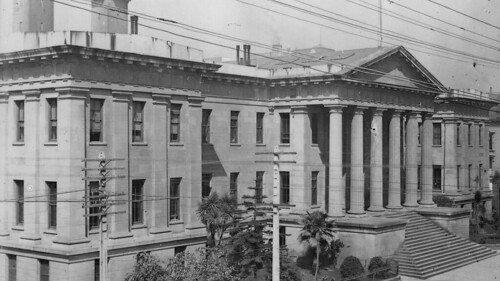
PREV ARTICLE
NEXT ARTICLE
FULL ISSUE
PREV FULL ISSUE
RENOVATIONS AT THE OLD SAN FRANCISCO MINT
The "Granite Lady", the old San Francisco Mint building, is undergoing a renovation. This article describes some of the work, which in many ways is about restoring the building to its original form by reversing architectural changes made over the years.
-Editor

New architecture is great, but in some cases people in the 19th century had things figured out just fine. Sometimes the best way to make a building cutting edge is to go back to the original design. The Mint--one of the few large buildings to survive the 1906 earthquake--generated coins until 1937. In 2003, the federal government sold it to the city of San Francisco to turn into a museum (the Museum of the City of San Francisco). That's where architecture firm HOK came in. "The Mint is this 19th century historic building that had a lot of unfortunate contemporary renovation done in the 1960s and 1970s. Our team peeled off these layers to find the old Mint and the old systems," explains Zorana Bosnic, Sustainable Design Director at HOK. "Although as a genre steampunk is better understood in design, art, literature, and movies, if you think about it, it's about celebrating the innovation of the 19th century that's deeply rooted in that kind of technology." Case in point: After removing the old layers of the building, the HOK team discovered that the Mint had five foot thick walls and basically was a giant thermal mass, making it naturally heat efficient. The Mint was also entirely reliant on natural ventilation. "If you think of the kind of industrial conditions in the Mint and how that system functioned then, surely we can find ways for that to be a prevailing system now," says Bosnic. But of course, years of thinking that new is always better made some of the Mint's features difficult to restore. The windows that helped provide natural ventilation were all sealed, and at some point a dropped ceiling was installed. "You would walk into spaces and feel like it's any other office building with a dark, dropped ceiling. A lot of that that had to be taken out in order to try and restore it," says Bosnic. There's one 19th-century leftover from the Mint that was perfectly intact: the building itself (something of a rarity post-1906 earthquake). The bottom slab of the building was made with a well-reinforced mat-slab foundation. There's also a trench around the structure--the thinking being that in a seismic event, you have to allow the entire building to move to preserve it. That's exactly what happened in the 1906 earthquake. Everything around the building was destroyed, and legend says that the entire Mint moved by two feet without causing any damage. "Those are the things where you get excited. It's the 19th century and they already thought of what we now know as the base isolation system which is now done with steel and a lot more technology," says Bosnic. "It's really important to rediscover that type of resilience." The Mint is still under renovation. No word yet on an opening date for the museum.
To read the complete article, see:
Steampunking An Old Building To Make It More Efficient
(www.fastcoexist.com/1679836/steampunking-an-old-building The Numismatic Bibliomania Society is a non-profit organization promoting numismatic literature. See our web site at coinbooks.org. To submit items for publication in The E-Sylum, write to the Editor at this address: whomren@gmail.com To subscribe go to: https://my.binhost.com/lists/listinfo/esylum All Rights Reserved. NBS Home Page Contact the NBS webmaster 
|